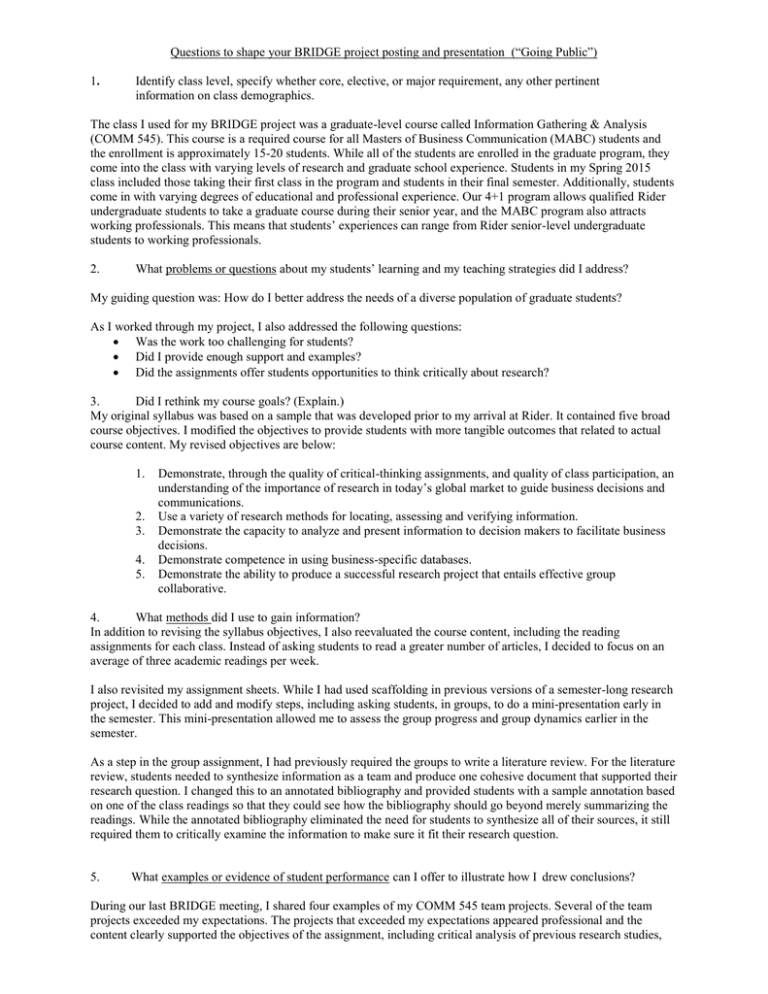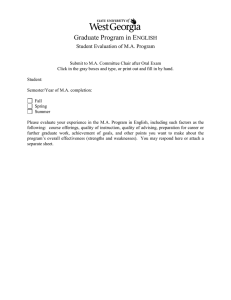Questions to shape your BRIDGE project posting and presentation ... . Identify class level, specify whether core, elective, or major requirement,...
advertisement

Questions to shape your BRIDGE project posting and presentation (“Going Public”) 1. Identify class level, specify whether core, elective, or major requirement, any other pertinent information on class demographics. The class I used for my BRIDGE project was a graduate-level course called Information Gathering & Analysis (COMM 545). This course is a required course for all Masters of Business Communication (MABC) students and the enrollment is approximately 15-20 students. While all of the students are enrolled in the graduate program, they come into the class with varying levels of research and graduate school experience. Students in my Spring 2015 class included those taking their first class in the program and students in their final semester. Additionally, students come in with varying degrees of educational and professional experience. Our 4+1 program allows qualified Rider undergraduate students to take a graduate course during their senior year, and the MABC program also attracts working professionals. This means that students’ experiences can range from Rider senior-level undergraduate students to working professionals. 2. What problems or questions about my students’ learning and my teaching strategies did I address? My guiding question was: How do I better address the needs of a diverse population of graduate students? As I worked through my project, I also addressed the following questions: Was the work too challenging for students? Did I provide enough support and examples? Did the assignments offer students opportunities to think critically about research? 3. Did I rethink my course goals? (Explain.) My original syllabus was based on a sample that was developed prior to my arrival at Rider. It contained five broad course objectives. I modified the objectives to provide students with more tangible outcomes that related to actual course content. My revised objectives are below: 1. 2. 3. 4. 5. Demonstrate, through the quality of critical-thinking assignments, and quality of class participation, an understanding of the importance of research in today’s global market to guide business decisions and communications. Use a variety of research methods for locating, assessing and verifying information. Demonstrate the capacity to analyze and present information to decision makers to facilitate business decisions. Demonstrate competence in using business-specific databases. Demonstrate the ability to produce a successful research project that entails effective group collaborative. 4. What methods did I use to gain information? In addition to revising the syllabus objectives, I also reevaluated the course content, including the reading assignments for each class. Instead of asking students to read a greater number of articles, I decided to focus on an average of three academic readings per week. I also revisited my assignment sheets. While I had used scaffolding in previous versions of a semester-long research project, I decided to add and modify steps, including asking students, in groups, to do a mini-presentation early in the semester. This mini-presentation allowed me to assess the group progress and group dynamics earlier in the semester. As a step in the group assignment, I had previously required the groups to write a literature review. For the literature review, students needed to synthesize information as a team and produce one cohesive document that supported their research question. I changed this to an annotated bibliography and provided students with a sample annotation based on one of the class readings so that they could see how the bibliography should go beyond merely summarizing the readings. While the annotated bibliography eliminated the need for students to synthesize all of their sources, it still required them to critically examine the information to make sure it fit their research question. 5. What examples or evidence of student performance can I offer to illustrate how I drew conclusions? During our last BRIDGE meeting, I shared four examples of my COMM 545 team projects. Several of the team projects exceeded my expectations. The projects that exceeded my expectations appeared professional and the content clearly supported the objectives of the assignment, including critical analysis of previous research studies, structured rationales that provided a foundation for future research, and well-thought out proposals that offered a potential research method(s) to address a business issue. While there was room for improvement in at least one assignment, the majority of students produced professional business documents that addressed business issues. 6. What theories or debates about learning frame or illuminate my inquiry? Nelson (2010) pinpointed 7 common teaching dysfunctions, including the misconception that providing more material correlates with more knowledge. This misconception is particularly relevant in a graduate research course in which one wants to provide students with the many nuances of research, including various methods, using academic sources, successful techniques, pitfalls, ethical considerations, and ultimately ways to communicate findings effectively to both academic and professional audiences. Instead of focusing on the many nuances, I limited the readings to enable students to grapple with a more structured set of concepts that closely correlated with class assignments. Another misconception is that students come to class with an understanding of how to write an essay (Nelson, 2010). In a similar manner, I previously assumed that students came prepared to read academic articles and effectively use sources to construct response papers. This semester, I included an explanation of how to critically examine and annotate articles in my syllabus. Additionally, I provided students with a non-graded assessment early in the semester to determine if we needed to review how to use sources. Many students needed information on not only how to use APA style, but also what type of information to cite, how to use quotes and how to synthesize the information as opposed to summarizing. By not assuming that students arrived with these basic skills, I was better able to meet their needs. Nelson, C. (2010). “Dysfunctional Illusions of Rigor: Lessons from the Scholarship of Teaching and Learning.” In L.B. Nilson and J.E. Miller (Eds.). To Improve the Academy: Resources for Faculty, Instructional, and Organizational Development, Vol. 28. San Francisco, CA: Jossey-Bass, A Wiley Imprint. 7. What have I learned (or what new hypotheses have I developed) so far? I’ve learned several key concepts: 1. It’s important to simplify materials and not expect that more learning occurs if more readings and resources are provided to students. As Nelson (2010) indicated, professors assume that because we provide students with more, they learn more. 2. Providing examples increases students’ understanding. This semester, I used a variety of examples from different sources, including trade books, academic articles, and student work. I also created my own examples to further support student learning. 3. Similar to undergraduate students, graduate students learn best from highly structured assignments. In previous semesters, I had hoped that students would use their critical thinking skills to model the academic readings, but what I found was that few students came equipped to read and apply what they learned. They needed more structure to guide this process. 8. Where will I go from here? I will continue to provide students with many models. In the next version of this class, I will create a model for how to develop an effective research question. While I did not have any modeling for developing an effective research question in graduate school, I think future students will benefit from more guidance here.


